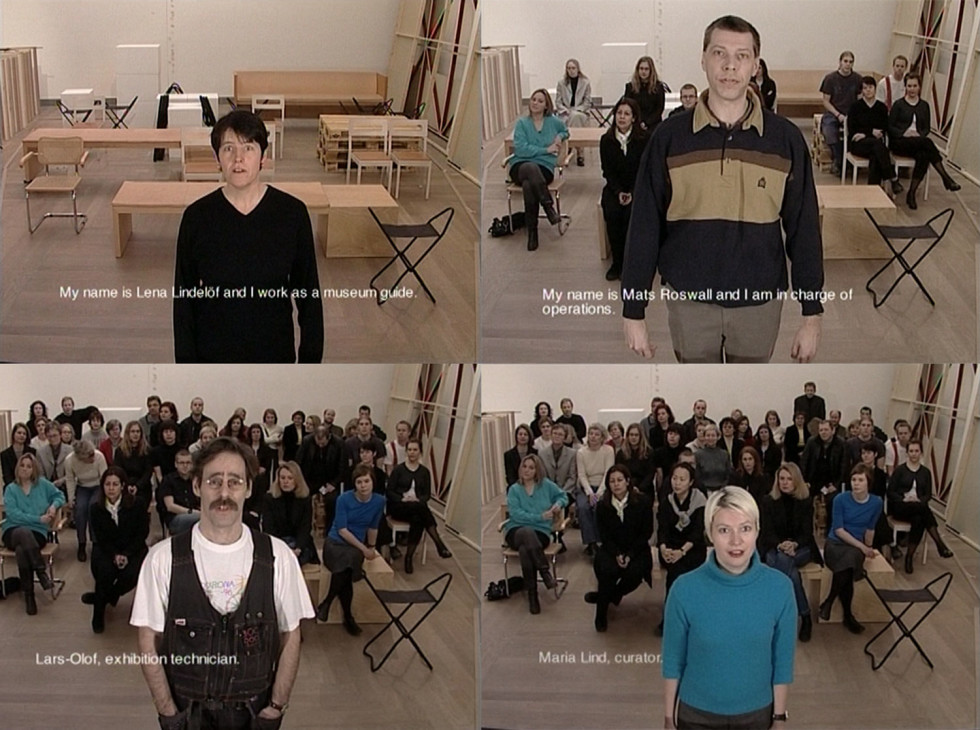
Annika Eriksson, Staff at Moderna Museet, 2000 The staff at the museum introduced themselves and gathered in front of a stationary camera. © Annika Eriksson
Annika Eriksson
Swedish representative at the XXV Bienal de Sao Paulo
23.3 2002 – 2.6 2002
Stockholm
This is how Annika Eriksson’s film about the staff at Malmö Museer (2001) begins. Annika Eriksson is part of Moderna Museet’s International Programme and represents Sweden at the São Paulo Biennial, which begins 23.03.02 (and ends 02.06.02). For the São Paulo Biennial, she has made a film about the staff behind this biennial. She has previously made a similar film about the staff at Moderna Museet, for the exhibition Organising Freedom (2000) at Moderna Museet.
Staff at Moderna Museet begins with a shot of an empty room, not necessarily an exhibition space even though it could be one. One after another members of the staff enters the room and state their name and position, and find somewhere to sit. As the film goes on it becomes almost impossible to find a seat. The chairs in the front remain empty up to the end.
It is very difficult to interpret the actions of the staff. Some seem used to act in front of the camera while others say their name and quickly step out of the picture. If one should see the film with no sound it would be almost impossible to know who has which title and where they are going to sit and if the chosen seat has a special meaning. You also start to wonder if there is any set order for how the staff enters the room. There doesn’t seem to be any specific order and all your interpretations are thrown aside. It seems as if the order is random rather than alphabetical or hierarchic. At the end of the film the staff are gathered in a group portrait, which gives a documentary feeling as well as a historical picture of a workplace in constant change.
As a visitor in a museum you only see the art and not the person working with it. Annika Eriksson plays with the rules of the museum when she exhibits its staff, thus making them the art. Her films clearly show the individual behind the impersonal and the tradition-bound history that museums usually have.
The film Annika Eriksson has made for the São Paulo Biennial resembles the previous films and completes the trilogy. It shows that people act alike all over the world, and regardless of how long they have worked together. As a viewer you try to place judgements about the people in the film but you soon realize that there is no support for these judgement and that they only exist in your own mind.
Annika Eriksson invites people to act as themselves thus showing both the individual and the collective and how they depend on each other. She is interested in showing the possibilities that arises when people work together, how people working together can create something such as a museum or a biennial. She places the normal but unknown in a new perspective and sees the individual as a link to the larger social and political configurations we find in today’s society.
Annika Eriksson’s participation at the São Paulo Biennial is organised by Moderna Museet’s International Programme. She has previously participated in Moderna Museet Projekt with Collectors (1998) and in the exhibition Organising Freedom (2000). Curator for the Swedish contribution to the biennial is Maria Lind, former curator at Moderna Museet and present director at Kunstverein München.
Annika Eriksson was born 1956 in Malmö. A richly illustrated publication produced by Super-design is available.
